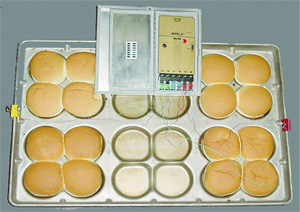
When Profits Heat Up
November 8, 2007
By Adam Bzowski
Checking for hot spots is only one way to increase your oven’s efficiency and bakery’s profits.
 In today’s world of mass production, bakers can no longer rely on sight, touch and taste as the only quality control methods. There are new technologies that help bakeries overcome challenges and move forward to meet stringent safety requirements and quality control aspects.
In today’s world of mass production, bakers can no longer rely on sight, touch and taste as the only quality control methods. There are new technologies that help bakeries overcome challenges and move forward to meet stringent safety requirements and quality control aspects.
One such technology is oven temperature profiling — the simple aspect of reading and monitoring the internal oven and product conditions throughout the bake process. Nowadays, more than ever, wholesale and commercial bakeries are adopting the use of temperature profiling as an important tool to improve quality, develop new products, and control costs.
Revenues in the baking industry are based on large production volumes and small profit margins. As a result, minimizing waste and developing a consistent baking process is always a high priority for bakeries of all sizes. In a world where the consumer is constantly demanding new products, and where modern baking ingredients and mechanical technologies allow for product development to complement these ever-increasing demands, temperature profiling is growing in popularity with Research and Development, Quality Control, and Maintenance Departments.
Temperature profiling is a method of evaluating operating oven temperatures and collecting the processed data to produce a thermal profile chart of the baking and heating processes within the oven. In essence, the profile provides a thermal fingerprint that indicates oven air temperatures and product temperatures and pre-set timed intervals throughout the baking process.
Prior to measuring the oven conditions, the logger is connected to a computer and, using included software, the required observing parameters (length of oven, conveyor speed, and interval rate of temperature readings) are set by the operator. Because temperature profile data loggers actually travel in the oven, they are designed to withstand extreme temperatures. The logger travels in a thermal barrier that protects the component from the intense temperatures of the bake oven. These resilient units gauge temperatures with thermocouple probes inserted into the product and/or pointed directly in the oven. The thermocouples provide constant monitoring of heat transfer and fluid dynamics within the oven. Measuring both conductive and convective heat outputs in the oven, bakeries are better able to pinpoint precise yeast kill locations and exact locality of oven cold or hot spots, affecting the final product.
After the data logger has completed its pass through the oven, it is removed from the barrier and plugged into a USB port on a computer docking station. The information gathered by the data logger is transferred to the software and a three-dimensional graph is created (see illustration). The easy-to-read graph becomes a powerful tool for oven remedial measures. Identifying exactly where irregularities exist within the oven, the temperature profiler provides your oven technician with the information required to rectify these issues.
Modern baking technologies rely heavily on enzyme blends and yeast strains for meeting consumer demands for consistent new product development. To ensure product safety and proper quality control, the yeast biochemical catalysts must be deactivated at certain temperatures and at a specific time in the bake process. In addition, in most wholesale baking operations, several varieties of product are baked on one oven, thus, the baking process must be amended to the broader spectrum of products produced. Surely, a bakery would produce much unwanted waste by baking grain bread loaves with the same oven setup as white loaves. The heat requirements and lateral burner flame adjustments are simply different. With the use of data loggers in the process, the bakery is better able to adhere to regulatory food safety standards and prepare the oven for optimum efficiency during product change based on historical set-up procedures generated with support of temperature profiling three-dimensional graphs.
As a function of maintenance and quality control, a temperature profile should be performed prior to and after oven burner maintenance, and any time new products are being evaluated for proper oven run temperatures and ingredient formulas. The purpose of oven profiling is to provide a detailed map of inadequacies within the oven, and adjust accordingly to provide reduced energy usage, increased consistency and reduced waste. Some corrective measures include: balancing of oven internal air distributors for better air circulation, adjustment to burners and combustion system, setting damper positions, and fine-tuning conveyor speed control. As a result of these adjustments, bakeries are able to achieve superior product with consistent texture, volume and bread color, and benefit from thousands of dollars in savings from reduced waste.
Bakers, by improving overall oven efficiencies with the use of temperature profilers, can realize an array of lasting benefits that will allow their bakeries consistently to improve the baking process. Adjustments to ovens will offer increased heat transfer, allowing production rates to rise. In addition, the improved efficiencies will have an excellent effect on product quality, reducing bakery waste and satisfying growing consumer demands for alternative products. Improved oven operations also equate to a reduction in energy usage, leading to further reduced expenditures. In a business where profit margins are based predominately on volume, finding other places that offer payback to the overall operation should be on every bakery’s agenda in an effort to maximize potential profitability.
Adam Bzowski is General Manager with Ordan Thermal Products Ltd., located in Markham, Ontario. Ordan Thermal offers parts, service, installation, and preventive maintenance for all bakery oven applications. Contact Adam at 905-475-9292 or go to www.ordanthermal.com.
Print this page
Leave a Reply